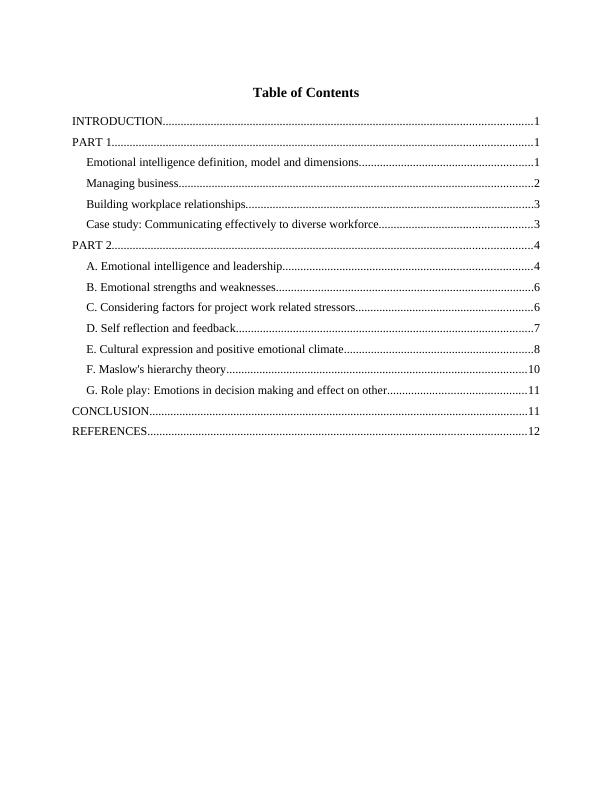Emotional Intelligence - Part 11: Definition, Model and Dimensions
Added on 2021-02-20
15 Pages4465 Words166 Views
Develop and useemotional intelligence

Table of ContentsINTRODUCTION...........................................................................................................................1PART 1............................................................................................................................................1Emotional intelligence definition, model and dimensions..........................................................1Managing business......................................................................................................................2Building workplace relationships................................................................................................3Case study: Communicating effectively to diverse workforce...................................................3PART 2............................................................................................................................................4A. Emotional intelligence and leadership...................................................................................4B. Emotional strengths and weaknesses......................................................................................6C. Considering factors for project work related stressors...........................................................6D. Self reflection and feedback...................................................................................................7E. Cultural expression and positive emotional climate...............................................................8F. Maslow's hierarchy theory....................................................................................................10G. Role play: Emotions in decision making and effect on other..............................................11CONCLUSION..............................................................................................................................11REFERENCES..............................................................................................................................12


INTRODUCTIONEmotional intelligence refer to ability of a person to identify and manage own emotionsas well as other emotions also (Agrawal, Gans and Goldfarb, 2017). This is very helpful inunderstanding emotions clearly and solving problems. Emotional intelligence can be developthough various ways such as practice self awareness, channelizing emotions, self motivation,creating healthier relationships by recognising emotions of other and value them. Emotionalintelligence play a very crucial role working in organisation. This will leads to create betterrelationship with other, self awareness, empathy, motivation and so on. This report is going tocover different aspect of emotional intelligent as well as proper understanding of this concept.Different models and dimensions has been used to gain better knowledge about this topic. Apartfrom this a proper report on emotional intelligence is developed. PART 1Emotional intelligence definition, model and dimensions.Definition:Emotional intelligence can be define as a capabilities of an individual tocontrol and manage their own as well as other emotions in better way. This concept waspopularized by Dr. Daniel Goleman in 1995, who was a psychologist and behavioural sciencejournalist. Emotional intelligence is very helpful in influencing emotions of other people anddeveloping better relationships. Golema's model application on a business environment: Daniel Goleman hassuggested emotional intelligence concept in order to get better understanding about emotional ofoneself and other within a workplace (AhnSung and Drumwright, 2016). This model in veryhelpful in improving functions of organisation as well as increasing its productivity. This modelis based on five components and its applicability on business environment is mention below.Self awareness- Employees who have strong emotional intelligence are very comfortablewith other and they have full control over their own thoughts or emotions. Self awarenesswill help them in better understanding about their strengths, weakness, values, goals aswell as its impact on others. They can guide decisions of other by using their gut feelings.Self regulation- This component is very useful in controlling and managing impulsiveemotions. Employees who have emotional intelligence can easy control and redirect1

End of preview
Want to access all the pages? Upload your documents or become a member.
Related Documents
Emotional Intelligence: Critical Analysis of Five Articleslg...
|18
|4049
|30
Introduction to Leadership in Businesslg...
|14
|4388
|59
Emotional Intelligence, Cultural Intelligence and Diversitylg...
|6
|1645
|40
Emotional Intelligence and Its Importance in the Workplacelg...
|7
|1732
|101
Emotional Intelligence, Cultural Intelligence and Diversity Assessment 2022lg...
|9
|1542
|13
Developing Emotional Intelligence - A Professional Workshop Planlg...
|12
|3109
|83
